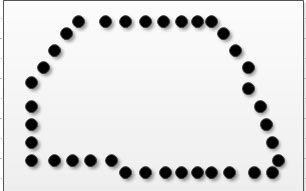Unfortunately, the concept of graphics of displaying pictures is lot more complicated than what has been described so far – evaluate the points using the equations, store them in a file and use raster graphics methods or use simple line drawing algorithms.
i) Stair case effects: Note that the pixel values are always integers (0,0) (0,1) (0,2) – – – – – — – -, but an algorithm to draw/manipulate pictures need not always return integer values. Suppose the point at which two line meet, say is at (1.4, 2.7). What do we do? Common sense suggests that we round off the values, by using any of the standard algorithms.
Excellent. 1.4 gets rounded of to 1 and 2.7 to 3. But another value of 1.6 say gets rounded off to 2 and a value of 3.1 also gets rounded of to 3. So, what do we have? The pointer 1.4 and 1.6, which should be very close to each other, appear to be separated by a distance of 1 and not 0.2 in our figure, i.e. the smoothness of a figure joining these points is lost. Alternately, the points 2.7 and 3.1, instead of appearing to be different, appear to be the same in our picture. A no. of such adjustments makes the figure looks like a jagged one instead of a smooth fig. 
ii) Response time: Especially when talking of animation, the speed at which new calculations are made and the speed at which the screen can interact are extremely important. Imagine a running bus, shown on the screen. Each new position of the bus (and it’s surroundings, if needed) is to be calculated and sent to the screen and the screen should delete the earlier position of the bus and display its new position.
All this should happen at a speed that convinces the viewer that the vehicle is actually moving at the prescribed speed, otherwise a running vehicle would appear like a “walking” bus or worse a “piecewise movement” bus. For this, most the speed of the algorithm and the speed of the display devices are extremely important. Further, the entire operation should appear smooth and not jerky otherwise, especially in simulation applications, the effects can be dangers.
iii) What happens when the size of the picture exceeds the size of the screen?:
Obviously, some areas of the picture are to be cut off. But this involves certain considerations and needs to be addressed by software. [Which we will discuss while discussing about clipping and windowing
iv) Can the user create pictures directly on the screen? Definitely all pictures can not be thought of in terms of regular geometric figures and hence in terms of equations? Now, seeing a particular picture on the screen, the viewer wants to change it slightly, say bend it slightly here, stretch it their etc. This may not suit any regular equation? How should the system handle it?
 Dinesh Thakur holds an B.C.A, MCDBA, MCSD certifications. Dinesh authors the hugely popular
Dinesh Thakur holds an B.C.A, MCDBA, MCSD certifications. Dinesh authors the hugely popular